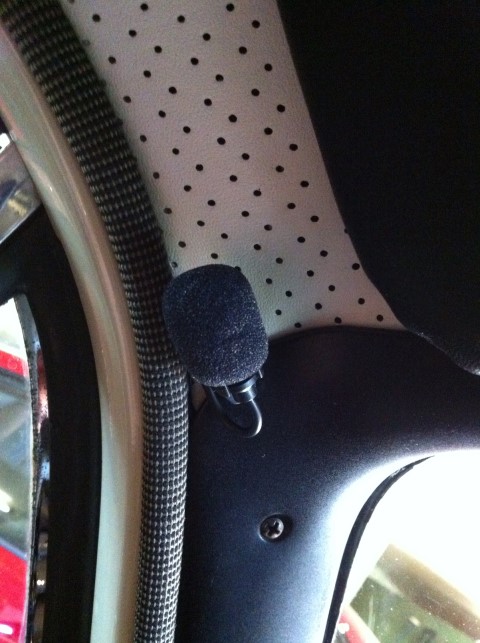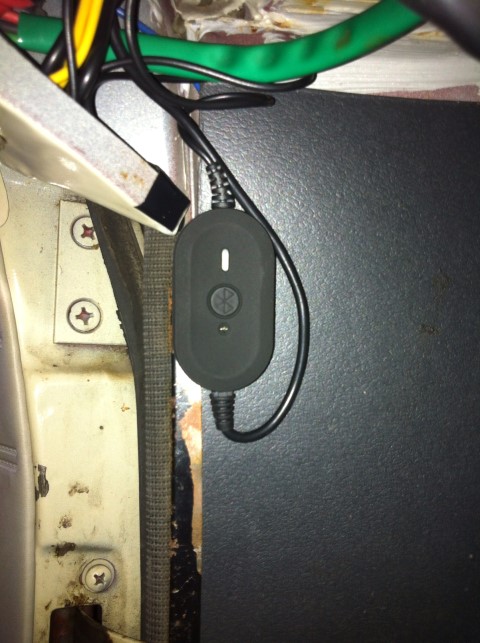This post deals with wireless network (WLAN or wifi) in Volvo XC70 MY13 and may be applicable to other Volvo models and model years as well. Keep reading…
Our Volvo XC70 has three power outlets (12VDC): one on the dash, one in the backseat and one in the trunk. They are wired differently. The one in the trunk is always live (even if the car is locked) while the other two are wired with the ignition. One of the best investments I have made so far in my life are the twin DVD-players with 7″ screens from NextBase that I installed for the girls in the backseat. Makes longer journeys all that much more delightful; from a nightmare to enjoyable for $550.
The problem with a rear seat entertainment system that is wired to the ignition is obvious. In order to be able to open the gas cap the engine needs to be switched off and if the engine is switched off then so is the ignition. So stopping for gas means an unwanted (for everyone involved) break in the current Disney feature. Another and more immediate problem is that the power plug to the RSE system builds more than an inch from the outlet. It’s only a question of time before the girls step on it while climbing around in the backseat like kids their age normally do, yielding an urgent need for a replacement cable at $45.

Following Camel’s hints, the problem is now solved by wiring a 30A relay to the trunk power outlet and controlling this relay with current from the trunk courtesy light. It turns out that this light is on for two minutes after the car is locked and for 30 minutes if the car is unlocked, so there is no chance that the new RSE wiring will drain the battery. By adding an additional power outlet controlled by this relay next to the trunk power outlet and by pulling a new cable with an outlet in the end to the center console between the front seats (there’s plenty of room behind the panel in front of the gear level), the RSE is powered from that outlet instead of the one in the backseat. Works like a charm. The RSE is still powered when the ignition is off, meaning the girls can continue watching their film. Component list and instructions below. The optional extra power outlet next to the stock outlet may come in handy for other applications (continue reading…)
Parts
From your local supplier, pick up the following:
- Cable, red, 1mm2, about 2m/6ft long
- 12V extension cord with power outlet in one end, about 3m/9ft long (39-058)
- 30A car relay w/ connections 30/51, 85, 86, 87 and 87a (36-112)
- Bridge rectifier (diode bridge) of, say, 100V 25A (90-054)
- Line fuse holder for 6.3x32mm glass fuses (or any other dimension that is easily available for you) (39-802)
- Two 6.3x32mm glass fuses of 500mA (fast) (41-110)
- Three branchers (67-245)
- 12V power outlet (39-090)
Part numbers from Kjell & Co, Sweden’s own RadioShack, for easy reference. Total cost for the above parts should amount to about $25. You will also need tape, bundle ties, terminal connectors and your usual set of tools.
A brancher looks like this: 
Attach the rectifier, relay and 12V power outlet to eachother to make it more manageable as one unit. I used epoxy glue. Bundle ties or even tape will probably do too, but you might aswell do things properly. Wire everything according to the diagram below, but save the connection to the existing trunk power outlet and the wire from the courtesy light until later.

For correct panel dismounts and (later) re-mounts, the official Volvo installation instructions for the luggage compartment power outlet are very handy. This outlet is standard on the XC70 but option on the cheaper V70 models (hence the instructions). They are available from Volvo here. Print a copy and keep as reference for all work on the panels in this guide.
Unlock the car and make sure all doors are open. Disconnect the car’s battery. This is important. Do not leave this step out. See the instruction manual for details, but essentially this step consists of opening the hood, removing the black plastic battery cover closest to the windscreen (it’s in two parts, one front and one rear – you want to remove the rear part), and fully disconnecting the minus cable from the battery. Make sure it’s removed properly and that it doesn’t tend to slide back towards the terminal on the battery.
Using your pocket knife, carefully remove the trunk courtesy light from the top panel. It will pop right out. You’ll find one white/blue and one blue/black wire behind it. Wire the line fuse holder to the white/blue wire using one of the branchers. Seal the brancher tightly and tape it. Also tape all wires before and after the brancher. Put one of the two fuses in the fuse holder and tape the other one to the fuse holder (according to Murphy’s Law, there will not be any spare fuses within a 100 mile radius if the fuse pops). Connect the 2m/6ft red cable to the other end of the fuse holder and detach the panels according to the Volvo instructions so that you are able to wire the red cable down along the right D-column. It’s easier than it appears and depending on how picky you are you may not even have to remove all panels mentioned in the instructions.

Remove the panels along the right side of the luggage compartment according to the Volvo instructions. Place the rectifier/relay/outlet combo behind the panel in front of the right D-column near the stock power outlet and attach it with bundle tie to the cables you find nearby – you don’t want it to drop down to where the terminals may come in contact with the chassis. Branch the plus and minus wires of the stock power outlet and connect it to the relay according to the wiring diagram above. Use a foot or so from the extension cord. Tape the branchers and the wires before and after them. Connect the red cable from the courtesy light to the rectifier (also according to the wiring diagram above). Cut the power plug end of the 12V extension cord. Loop the bare wires in a nice, concealed and non-obstructive way from under the center console between the front seats backwards towards the trunk. This is swift and easy with the panels removed. Connect its plus and minus wires to the relay (same terminals as the extra power outlet with the rectifier/relay/outlet combo). Re-mount the panels according to the Volvo instructions. Reconnect the battery (which is a reverse procedure of what you did before) and reset the clock in the car.
The added power outlet controlled by the relay can be used to power a 12V wireless 4G/LTE router. By placing the 4G/LTE modem behind the panel on the left D-column and wiring the USB-cable through the spare tire well to behind the panel on the right D-column, the 4G/LTE antenna will not interfere with the WLAN antenna. The modem and the router need about two minutes to boot up, but the rest of the time there is 80MBit/s WLAN in the car. I chose a Dovado Tiny router with the accessory 12V cable, as it works a vast range of both 3G and 4G modems, is fast and easy to set up and configure. Its config includes controlling the PIN of the SIM in the modem so even if the modem gets stolen it is still protected by the PIN until you notice and can have the operator block it. Both the router and the modem are easily accessible through the removable side panels of the XC70.

Modem
|

Router
|
In this installation everything looks stock and almost everything can be reversed to original, but if you for instance use your 4G/LTE modem with other devices and/or in other areas than in your car you may want to consider an USB outlet in the panel instead (i.e. just sticking the modem into the USB outlet whenever you travel with the car). Maybe a power switch and an indicator LED for the router to go with that?
Waiver. This guide has been prepared for and verified with the Volvo XC70 MY13 and is likely (but not guaranteed) to be applicable to the same model from MY08. Understand that tampering with the electric system may void the warranty of the car. Do not perform these steps if you do not fully understand the setup, the wiring and the implications. The text in this guide has been prepared with uttermost care but is, despite of that, to be regarded strictly as a guide to be used in conjunction with normal and cautious vehicle shop practice, including the safe operation of electric equipment. I cannot accept liability for your actions. Work smart! Work safely!















